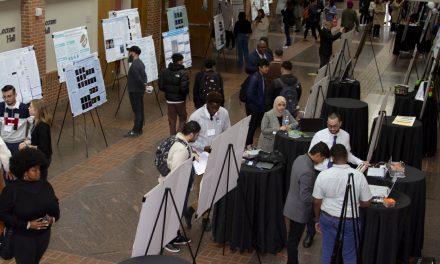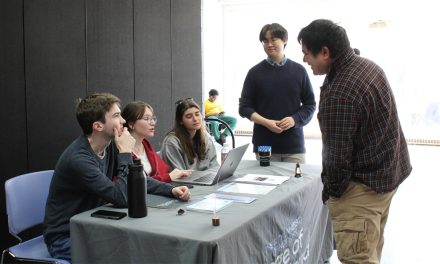The annual Regional Commuter Choice Awards program recognized the College of Staten Island’s regional leadership in traffic and transportation issues by awarding the College a 2008 Regional Commuter Choice Innovator Award and the prestigious Leadership Award during their annual ceremony on June 27 in the Whitehall Ferry Terminal in lower Manhattan.
CSI “has been selected as a recipient… for offering commuter benefits options that provide employees with alternatives to the high price of gas, enhance the community, reduce traffic congestion and improve the air we breathe,” wrote Joel Ettinger, executive director of the NY Metropolitan Transportation Council and John Galgano, president of CommuterLink, Inc.
“CSI is involved in improving transportation in the Southern Corridor of New York State in many ways,” commented Jonathan Peters, an associate professor of finance at CSI and a noted regional expert in transportation issues. “As a major employer and trip destination in the region, CSI is actively involved in identifying and providing effective mass transit alternatives to allow students and staff to travel without the use of private automobile. The College is also a center of transportation research that has both theoretical as well as applied uses in the community, and we are engaged in ongoing outreach efforts with community groups, public agencies, and political leaders to provide technology transfer of the best practices in transportation systems and urban planning to the community.”
These significant contributions to reducing traffic and congestion at a regional level as well as the College’s significant progress in reducing its dependency on private automobile travel, helped earn them this top award.
“Our work on regional traffic modeling, as well as our work on regional planning through the Center for the Study of Staten Island, was seen as significant contributions to the region and the economy,” Peters added.
CSI’s new Ferry Shuttle service, which provides a direct link between the Willowbrook campus and the St. George Ferry Terminal, as well as the S-93 express bus that connect the campus with Bay Ridge, Brooklyn, were also noted as key initiatives of direct importance.
“Receiving this distinguished award would not be possible without the hard work and dedicated vision of our faculty and staff,” commented CSI President Tomás Morales. “And we are proud of Jon Peters and Interim Provost Mike Kress for helping make this extraordinary achievement possible.”
STATEN ISLAND BACKGROUND
Staten Islanders currently face the worst commute in the nation. With an average journey to work of 41.3 Minutes (statistically tied with Queens, The Bronx, Brooklyn, and Prince William County, VA), an average mass transit commute of 68.6 minutes – the longest in New York City, and the highest percentage of extreme commuters – 11.8% (90+ minutes each way) in the nation, Staten Islanders suffer extensively during their daily commuting.
The College of Staten Island, based upon its strategic plan for 2000-2006, set out in 2000 to create a center of study for the social problems facing Staten Island. The Center for the Study of Staten Island was established in 2002 for this purpose. High on the priority list of problems was transportation and in 2004 the Center held its first conference: Transportation on Staten Island. Out of that conference came a call from local business leaders to study transportation issues in greater detail. Based upon this significant need, a research study was funded through the Staten Island Chamber of Commerce. This report has helped focus the community and political support for transportation improvements on Staten Island and has provided some of the core issues of the Mayor’s Staten Island Transportation Task Force.
With the largest campus in New York City (204 acres), the College continues to work to provide innovations in transportation systems to create better on- and off-campus mobility. Current plans call for strategic partnerships with GoLoco to provide car sharing alternatives, reconfiguration of the on-campus shuttle bus system, improved linkages to New York City Transit Bus routes, and identification of student home locations for transit route planning.
CSI TRANSPORATION INITIATIVES OVERVIEW:
S-93 Bus: The College of Staten Island launched limited stop service between Brooklyn and CSI in 2004. Current average daily ridership on the limited service line is currently over 1,300 people. Usage grew by 58% in 2007 versus 2006.
CSI Ferry Shuttle: In spring 2008, CSI President Tomás Morales instituted a pilot direct Staten Island Ferry shuttle for College of Staten Island students and staff. This shuttle is able to reduce travel time for students from about 45 minutes on the S-62 to about 25 minutes on the shuttle. Ridership was about 15,000 riders for the one-month (about 700 riders per day) pilot ending March 28, 2008. The Shuttle enters full-time service for the fall 2008 semester
S-89 Bus: The College of Staten Island through the CSI – Staten Island Project provided extensive analysis and also support to community groups and political leaders as to the value of the S-89 route to the Hudson Bergen Light Rail. Successful establishment of this route has allowed over 800 people per day to utilize this limited service line. Current ridership on the route is reported to include 20% outbound ridership from New Jersey to Staten Island in the morning.
GEM Cars: The College of Staten Island operates a fleet of 25 electric Daimler-Chrysler GEM cars on campus to provided enhanced mobility for staff members. This fleet currently provides 92% of the electric vehicle miles provided by the New York Power Authority in Richmond County.
CSI REGIONAL EFFORTS:
Toll Plaza Flow Modeling: Acting Provost Michael Kress and Associate Professor Jonathan Peters have developed a number of traffic flow models to evaluate the flow characteristics of the regional toll bridges and roads. Models developed to date include the Outerbridge Crossing, The Verrazano Narrows Bridge, and the Raritan Toll Plaza on the Garden State Parkway. Using the Transmodeler and the GPSS Simulators, they are able to estimate the flow conditions, congestion, and air pollution caused by toll plaza performance. Results of these models have been requested by the Borough President of Staten Island and state/city elected officials.
Transit Route Identification: The College, through the use of Geographic Information Systems (GIS) technology, has been a leader in the identification and analysis of transportation-ready and transit-oriented development sites on Staten Island. Jonathan Peters, Alan Benimoff, Michael Kress, and Nora Santiago of the CSI GIS Group have analyzed the potential location of light rail stations on the West Shore of Staten Island and Bus Rapid Transit routes on the North Shore and Central Core of Staten Island. In addition, the team has identified possible sites for additional stations on the Staten Island Rapid Transit and sites for transit-oriented development in the community.
Participation in Studies and Projects: The College serves as a community resource, and members of the faculty serve on numerous transportation community panels. For example, CSI staff members serve as resources for the following studies:
SIEDC Comprehensive Development Strategy: SI Economic Development Corporation
Staten Island 2020 Study: Center for an Urban Future
Staten Island Social Capital Survey: The College of Staten Island
Staten Island Transportation Survey: The College of Staten Island
New Jersey Road Monetization Analysis: New Jersey State Assembly
New York City Congestion Pricing Zone: Comparisons to London: National Academies of Science — Transportation Research Board
Staten Island Housing Study: New York State Assembly
Population Estimates Challenges: New York City Planning
West Shore Study: New York City Planning
CUNY High-Performance Computational Center (CUNY-HPC): The College of Staten Island is home to the CUNY HPC and is developing a suite of modeling techniques that will be applied to regional development and transportation modeling. In particular, Jonathan Peters, through the University Transportation Research Center — Region II is working on a study of economic competitiveness for the State of New York Department of Transportation. One goal of the study is to identify the ability of the transportation system to serve the economic needs of the community. As such, we are working to develop a comprehensive set of metrics of system performance that can be measured in close to real time for the transportation system.














